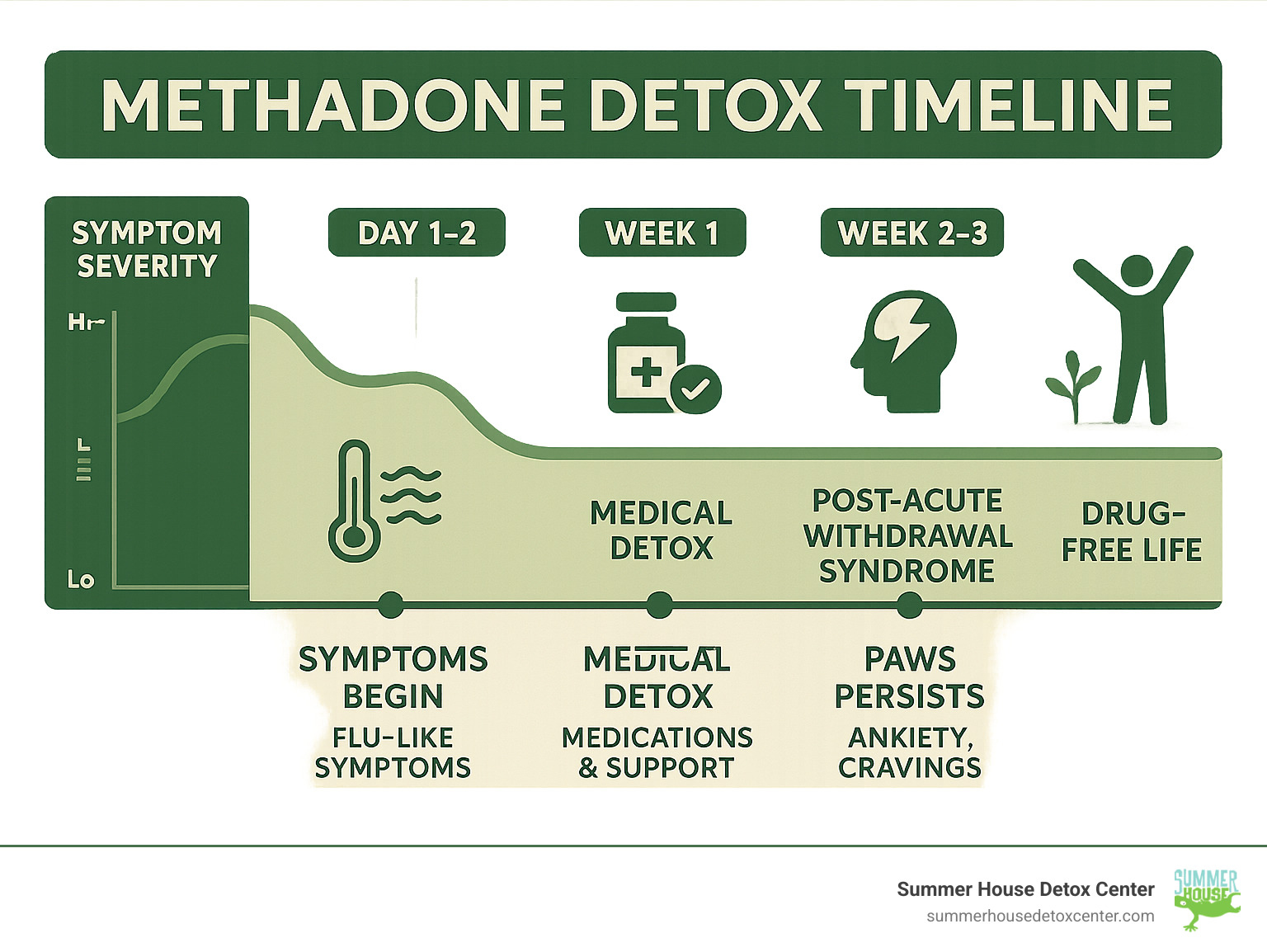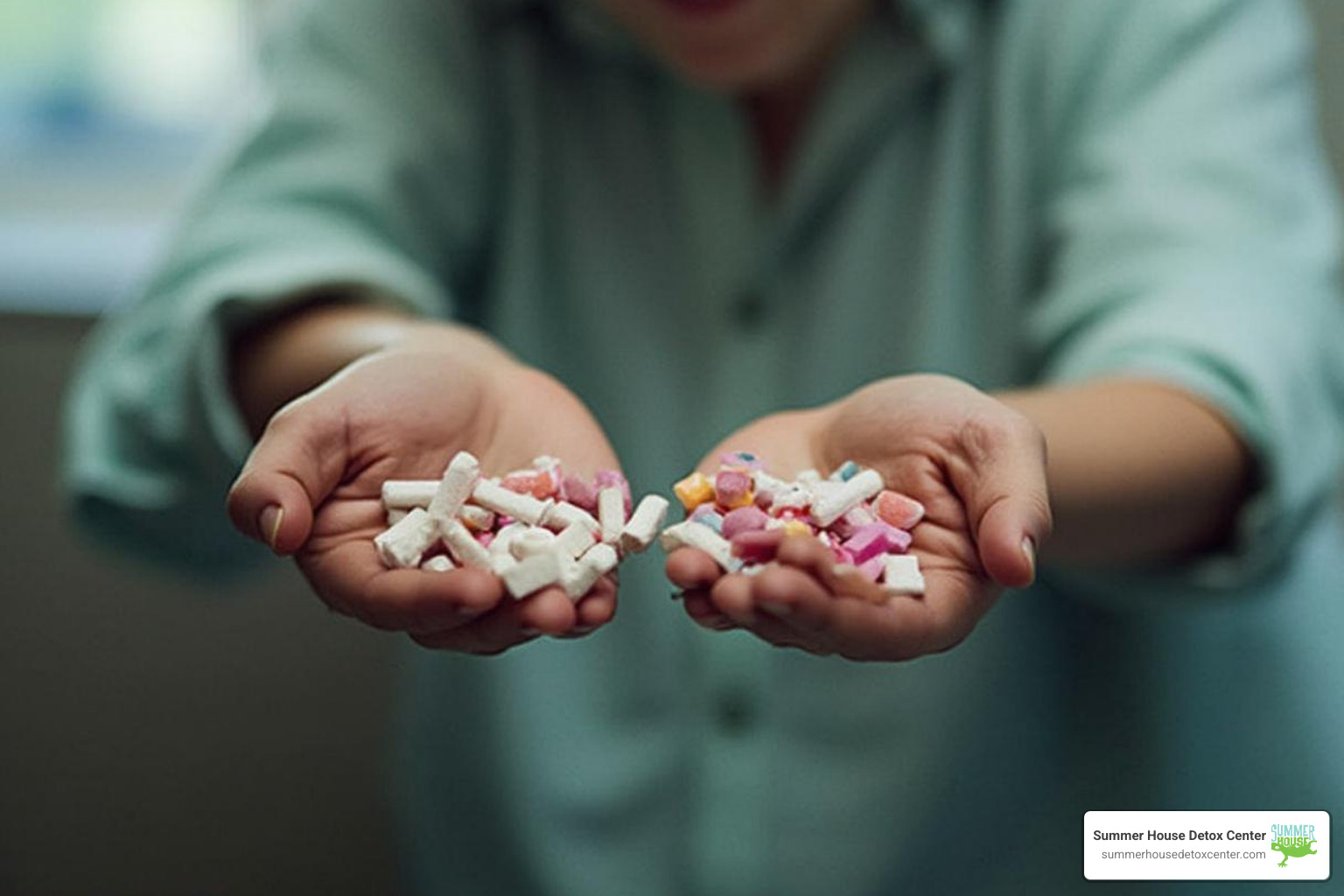Understanding the Journey of Methadone Detox
Detoxing from methadone is a complex process requiring medical supervision. While methadone is a vital treatment for opioid use disorder, many individuals eventually wish to stop the medication and achieve a drug-free life.
Key facts about methadone detox:
- Timeline: Acute withdrawal symptoms typically begin 24-36 hours after the last dose and can last 2-3 weeks, with some effects persisting for months.
- Symptoms: Include flu-like symptoms, muscle aches, nausea, anxiety, insomnia, and intense cravings.
- Safety: Medical supervision is essential due to risks of severe dehydration, relapse, and potential psychological complications.
- Duration: The process varies based on dosage, length of use, and individual health factors.
- Success factors: Gradual tapering, comfort medications, and comprehensive support significantly improve outcomes.
With a long half-life of 15-55 hours, methadone withdrawal is more prolonged and challenging than for shorter-acting opioids. Symptoms are often more severe and last longer, making at-home or “cold turkey” detox dangerous and likely to result in relapse.
However, successful methadone detox is achievable with proper medical care. A professional medical detox provides 24/7 monitoring, comfort medications, and the emotional support needed to steer this challenging process safely.
Medical guidelines advise against methadone withdrawal for pregnant women due to significant risks. For all others, the process requires patience, as Post-Acute Withdrawal Syndrome (PAWS) can persist for months after acute symptoms resolve.

Quick look at detoxing from methadone:
Understanding Methadone: From Treatment to Tapering
Methadone is a long-acting opioid agonist used in methadone maintenance treatment (MMT) for opioid use disorder (OUD) and for chronic pain management. It works by binding to opioid receptors in the brain, which reduces cravings and prevents withdrawal symptoms without causing the euphoric high of other opioids.

Its effectiveness has earned it a place on the World Health Organization’s (WHO) list of essential medicines. Understanding how it works and differs from medications like Suboxone is vital. Learn more in our guide: Methadone vs. Suboxone: How Do They Differ?.
What is Methadone and Why is it Used?
Methadone is an FDA-approved synthetic opioid for medication-assisted treatment (MAT) of OUD and for pain management. It acts on the brain’s opioid receptors to stabilize brain chemistry, reducing the intense cravings and severe withdrawal symptoms that fuel addiction.
For OUD, methadone prevents withdrawal and blunts the effects of other opioids, allowing individuals to focus on recovery. For pain, its long-acting nature provides sustained relief. Recognizing the Signs of Opiate Addiction can clarify why such treatments are essential.
Benefits of MMT vs. Reasons for Wanting to Stop
MMT offers significant benefits for those with OUD, including:
- Reduced risk of fatal opioid overdose.
- Lower rates of HIV/HCV transmission from injection drug use.
- Improved life stability (employment, school).
- Reduced drug-related criminal activity.
- Better health outcomes for pregnant women with OUD.
Despite these benefits, individuals may choose to stop methadone for several reasons:
- Long-term side effects like constipation, fatigue, or sexual dysfunction.
- The social stigma and daily routine of clinic attendance.
- A personal desire to live a life completely free of all substances.
- Impatience with the long-term commitment, which NIDA suggests should be at least 12 months.
Whether due to side effects or a desire for complete abstinence, the decision to stop methadone is deeply personal. Our guide on How to Get Off Methadone offers further insights.
The Methadone Withdrawal Timeline and Symptoms
Detoxing from methadone is notoriously challenging. As a long-acting opioid, it leaves the body slowly, resulting in a prolonged withdrawal process. When a physically dependent person stops taking it, the body undergoes an intense and uncomfortable adjustment period.
The process is complicated by Post-Acute Withdrawal Syndrome (PAWS), where psychological symptoms can linger for months or even years after acute withdrawal. Understanding the full scope of symptoms is key to preparation. For more details, see our guide on What Are the Symptoms of Opiate Withdrawal?.

Common Methadone Withdrawal Symptoms
Methadone withdrawal symptoms are similar to those of other opioids but are often described as more prolonged and severe. Knowing what to expect is a critical part of preparation. Common symptoms include:
- Severe flu-like symptoms: Deep muscle and bone aches, chills, and fever.
- Gastrointestinal distress: Nausea, vomiting, and diarrhea, which can lead to dehydration.
- Psychological distress: Intense anxiety, restlessness, and a feeling of being unable to get comfortable.
- Sleep disturbances: Severe insomnia despite extreme fatigue.
- Autonomic symptoms: Profuse sweating, and hot and cold flashes.
- Overwhelming cravings: Intense psychological urges for methadone or other opioids.
- Mood changes: Severe depression, hopelessness, and anhedonia (inability to feel pleasure).
- Other physical signs: Yawning, watery eyes, runny nose, goosebumps, rapid heart rate, high blood pressure, dilated pupils, and abdominal pain.
A Typical Timeline for Detoxing from Methadone
The detox timeline varies based on dosage, duration of use, and individual health, but a general progression can be outlined:
- Early Phase (24-36 hours after last dose): Mild, flu-like symptoms begin, including anxiety, restlessness, runny nose, sweating, and trouble sleeping.
- Peak Phase (Days 3-8): Symptoms intensify significantly. This phase includes severe drug cravings, muscle cramps, body aches, nausea, vomiting, and diarrhea. The peak may be delayed for some, highlighting methadone’s long-acting nature.
- Lingering Symptoms (Weeks 2-6+): While the worst physical symptoms subside, fatigue, low energy, sleep problems, anxiety, depression, and cravings can persist for weeks or months.
- Post-Acute Withdrawal Syndrome (PAWS): For long-term users, PAWS can cause ongoing mental and emotional challenges like mood swings, anxiety, and depression for several months up to two years, emphasizing the need for long-term support.
Understanding this timeline is crucial for setting realistic expectations for detoxing from methadone. Our guide Methadone Detox 101 digs even deeper into the process.
The Critical Importance of Medical Supervision
When considering detoxing from methadone, medical supervision is not just a suggestion—it’s essential for safety and success. The long and intense nature of methadone withdrawal presents unique risks that are best managed in a professional setting. Attempting to detox without support can lead to severe dehydration, a high risk of relapse, and other serious medical complications.
At Summer House Detox Center, we provide constant medical care and emotional support. Many of our staff have personal recovery experience, offering both professional expertise and deep empathy to guide you safely through withdrawal. Learn more about The Importance of Medically Supervised Detox and What to Expect During Your Detox Experience.
The Dangers of Detoxing from Methadone at Home or ‘Cold Turkey’
Attempting to detox from methadone at home or ‘cold turkey’ is extremely dangerous. The reality of withdrawal is far more complex and challenging than many realize. Key dangers of unsupervised detox include:
- Intense Withdrawal: The severity of symptoms can be unbearable without medical management, leading to a high risk of relapse.
- Overdose Risk: Relapsing after a period of abstinence is especially dangerous, as tolerance is lowered, making a return to a previous dose potentially fatal.
- Medical Complications: Severe vomiting and diarrhea can cause life-threatening dehydration and electrolyte imbalances. Pre-existing health conditions can also be dangerously exacerbated.
- Unmanaged Psychological Distress: Severe anxiety, depression, and intense cravings can be overwhelming without professional support, increasing the risk of self-harm.
Can Methadone Withdrawal Cause Severe Psychological Symptoms?
The psychological symptoms of detoxing from methadone can be as severe as the physical ones and require immediate professional attention.
While rare, some individuals may experience psychosis, including paranoid delusions or hallucinations. Case studies have documented this phenomenon, highlighting the need for close psychiatric monitoring during withdrawal.
Severe depression is also common, characterized by intense sadness and hopelessness. The combination of physical pain and emotional distress can lead to suicidal thoughts, a serious risk that requires constant professional monitoring.
These potential symptoms underscore the need for psychiatric oversight during detox. A comprehensive program addresses these mental and emotional challenges, with therapy being a crucial component for lasting recovery. Learn more about The Role of Therapy in Detox.
Safe and Effective Strategies for Detoxing from Methadone
Successfully detoxing from methadone is possible with a plan that prioritizes safety, comfort, and well-being. At Summer House Detox Center, we reject a one-size-fits-all approach, instead crafting personalized treatment plans for each individual’s unique journey.
Our plans include a careful needs assessment, comfort medications, nutritional support, and holistic therapies to create a supportive environment for healing.
Our goal is to make your detox as comfortable as possible, helping you move toward a drug-free life with dignity and support. Learn more about our approach to Opiate Detox Treatment.
Medically-Assisted Treatment (MAT) and Tapering
The safest method for methadone detox is a medically supervised taper. Unlike quitting ‘cold turkey,’ this involves gradually reducing the dose over time. This slow approach allows the body to adjust, minimizing the severity of withdrawal symptoms.
A typical taper involves reducing the dose by 5-10% at regular intervals (e.g., weekly or bi-weekly), with the pace personalized to your response. This prevents overwhelming acute withdrawal and improves comfort.
During the taper, other medications can ease symptoms. Buprenorphine can be used to stabilize patients and smooth the transition. Clonidine is effective for managing physical symptoms like anxiety, high blood pressure, and restlessness, and is administered under close medical supervision.
This combination of MAT and a gradual taper provides a controlled, safe, and comfortable path through detox, scientifically proven to increase success rates. Learn more about our Detox Services: Medication-Assisted Treatment.
Managing Symptoms and Ensuring Comfort
Beyond tapering, ensuring comfort is central to a successful methadone detox. Our medical team provides specific medications to manage withdrawal symptoms effectively and humanely.
We use a range of comfort medications, including anti-nausea medications, sleep aids, pain relievers, and anxiety medications to address specific symptoms as they arise. In cases of severe vomiting or diarrhea, we provide IV fluids for hydration to prevent dehydration and maintain electrolyte balance.
Comfort also comes from the environment. We provide a calm, supportive, and compassionate setting with comfortable accommodations and a dedicated staff, allowing you to rest and focus on healing.
We also emphasize nutritional support, providing balanced meals and supplements to help your body heal and regain strength, as methadone use can affect digestion and nutrient absorption.
This comprehensive approach makes the detox journey more manageable. Learn more about Managing Withdrawal Symptoms.
Frequently Asked Questions about Methadone Detox
It’s natural to have questions when considering detoxing from methadone. Here are clear answers to some of the most common concerns.
How long does methadone withdrawal actually last?
The duration of methadone withdrawal varies for each person, but a general timeline can be provided.
The acute phase, or the period of most intense physical symptoms, typically lasts two to three weeks, peaking around days 3-8. Following this, Post-Acute Withdrawal Syndrome (PAWS) can occur, where psychological and emotional symptoms (mood swings, anxiety, sleep issues) persist for months or even up to two years.
The exact duration depends on several factors:
- Dosage: Higher doses may lead to a longer detox.
- Duration of use: Long-term use often extends the withdrawal timeline.
- Individual health: Metabolism and overall physical and mental health play a role.
- Tapering schedule: A gradual, supervised taper can significantly reduce the severity and perceived duration of withdrawal.
Can pregnant women safely detox from methadone?
This is a critical question. The medical consensus is that pregnant women should NOT attempt a ‘cold turkey’ detox from methadone. Abruptly stopping opioids during pregnancy poses significant risks to both mother and baby.
Rapid withdrawal can cause severe stress on the body, leading to miscarriage or premature labor. While methadone maintenance treatment (MMT) can result in treatable Neonatal Abstinence Syndrome (NAS) in the newborn, the risks of abrupt withdrawal to the fetus are far greater.
For these reasons, continuing MMT is the standard recommendation for pregnant women with OUD, as it provides stability and leads to better outcomes. In rare cases, a very slow, carefully supervised taper may be considered, but the health of the mother and baby remains the top priority.
What happens after detox is complete?
Completing detox is a critical first step, but it is just the beginning of recovery. Detox addresses physical dependence, but ongoing treatment is necessary to address the psychological and behavioral aspects of addiction.
The next step is transitioning to a comprehensive treatment program, which may include:
- Inpatient rehab: A structured, 24/7 therapeutic environment.
- Outpatient programs (PHP/IOP): Flexible yet intensive treatment options.
- Therapy and counseling: Individual, group, and family sessions to address root causes.
- Support groups: Peer-led communities like Narcotics Anonymous (NA) for shared experience and encouragement.
- Aftercare planning: A personalized plan for managing triggers and maintaining sobriety long-term.
The journey to a fulfilling life in recovery begins after detox. We can help guide you through these crucial next steps. Learn more here: From Detox to Recovery: The Next Steps.
Your Path to Recovery Starts Here
Detoxing from methadone is a significant undertaking, but it is an achievable journey with the right support.
We’ve explored methadone’s long-acting nature, its marathon-like withdrawal process, and the potential for severe psychological symptoms. This is why professional, medical supervision is non-negotiable. Attempting to detox at home or ‘cold turkey’ is unsafe, carrying risks of extreme discomfort, medical emergencies, and relapse.
At Summer House Detox Center, we offer a personalized, medically supervised detox experience centered on your comfort, dignity, and success. Our 24/7 team, many with personal recovery experience, provides both professional expertise and compassionate understanding. We use evidence-based strategies and comfort medications to manage withdrawal symptoms and prepare you for the next steps in your recovery.
If you or a loved one is considering detoxing from methadone, you don’t have to do it alone. Your path to a new life begins with seeking the right support.
Ready to take the first step? Explore our dedicated Methadone Detox Services or learn more about our comprehensive Drug and Alcohol Detox in Miami, FL. We are here to guide you toward a life free from dependence.

